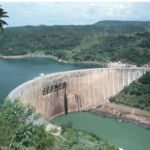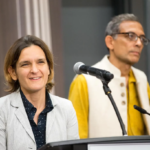Very brief, broad base report by SOUMYA DUTTA, from the ongoing UNFCCC 25th Conference of Parties CoP-25, in Madrid, with Chilean presidency (Santiago was supposed to host, but had to cancel due to ongoing mass protests.)
Thx.
____
Main issues under discussion /negotiation —
1. Upgrading Ambition. As is widely known, the GHG reduction pledges (global ‘climate change governance’ has moved to a pledge & review system – basically “this is what we will do” regime from a science based binding commitment regime) og different country governments, submitted to UNFCCC at Paris 2015 CoP-21 and later, are very weak. Even if all these are fully implemented, a global temperature rise of 3-4°C will happen by 2100, and the 1.5 & 2 C redlines might be breached by 2035 and 2050-60. This CoP is deliberating on how country governments can upgrade their pledges (submitted through their so-called NDCs – Nationally Determined Contribution) to help keep global mean temperature rise well below 2°C by 2100, and possibly below 1.5 C. (No realistic chance anymore).
Meanwhile, after being flat from 2014-2016, global CO2 & other GHG emissions are again rising. By IPCC estimates, the total GHG emissions have crossed 55 Gt in 2018, and NEED TO FALL BY AT LEAST HALF BY 2030. Slim chance as of now. Pl recall, our South Asian People’s Action on Climate Crisis SAPACC demands a more progressive & needed ‘ net-zero’ emission by developed countries by 2030, and by 2040 by developing ones.
At the next year’s 2020 CoP-26, at Glasgow, UK, countries are supposed to submit their upgraded/ higher ambition NDCs. Those negotiations are ongoing here. Watch out.
2. Finalizing the “Paris Rulebook”. After the Paris agreement was signed by most countries, starting Dec.2015, there is an ongoing negotiation process on formulating internationally accepted rules for each aspect of the agreement. This is called the Paris Rulebook, and is a major topic of discussion/ negotiation here. A roughly 300 page Rulebook is nearing finalization, BUT,
3. Market Mechanism, a highly contentious issue.
Article 6 of the Paris Agreement defines market (& non market cooperative) mechanisms for both mitigation (reduction of projected GHG emissions) and other (helping countries, outcomes, like commitments to renewable energy capacity etc.
Article 6.2 — talks about Internationally Transferred Mitigation Outcome ITMO. This is between governments. To simplify, a country that pledged certain amount /percentage of emissions reductions in its NDC, and failing to do that by the timeline, can ‘buy’ mitigation outcomes from another country which have exceeded its NDC commitment on mitigation ! Please note that over 50% of the country NDCs include Market mechanisms as a means of achieving their pledges of emission reduction. Anyone remember Emissions Trading Scheme ETS from the earlier Kyoto protocol, how it completely failed to reduce emissions, how global and national frauds happened, …..?
Many Civil society groups and collectives, forest groups etc are opposing these new market mechanisms ‘tooth & nail’. ‘Client NGOs’ here, however (including from India) are voicing ‘niceties’ like -“market Mechanism is ok, but should respect human rights, should avoid double counting (by the selling and buying countries) etc. Issue still not settled.
In a press conference on Dec.05, 11:00–11:30 am, at PC hall “Mocha” here in the CoP-25 venue, While I was exposing the logical flaws & bad experience of the earlier Kyoto Market mechanisms (some from my own field and other studies), while a NGO representative was saying those niceties to defend market Mechanism in a sense. Country governments like several east European ones, India etc are bargaining hard for “carrying over” their Kyoto period carbon credits, to the new market Mechanism, post 2020. Social movements and some countries are opposing this, as this will make even a diluted pledge, even more dilute, with often no real emission reduction giving mitigation outcomes by these past fraudulent carbon credits.
Article 6.4 – talks about creating a “New market Mechanism” for ‘voluntary trading’ of mitigation credits between public, private and other entities. This, in effect, will create a so called “Sustainable development mechanism” SDM, in place of the old Kyoto CDM (“clean development mechanism”). A board under the UNFCCC will be created to administer this new market, as there was the CDM executive board earlier. The main beneficiaries of the CDM were big polluting companies in China, India, Brazil, …..while millions of poor people living around those CDM projects, suffered even more from those projects. Taking a few names will make this clear — very big monetary benefits under the earlier market Mechanism of CDM were Gujarat Chloro Fluro Chemicals, Reliance Sasan 4000 MW ultra mega coal power plant, Adani Mundra 4620 MW mega coal power plant, big solar & wind farms etc.
Article 6.8, only this article directs non-market transfer of mitigation & other pledge outcomes.
4. The other big debate is on “Loss and Damage”.
Inspite of adaptation, huge losses due to Climate disruptions are happening and will increase. The poor countries are asking for Money for these losses. The developed countries are averse to accept the concept of reparation/ compensation, as the fear these might open the flood gates for claims.
It’s only nearing the 1st week of the 2-week negotiations. The second week sees the heat of negotiations go up (nego-warming leading to change in climate of cooperation).
——-++++++++++
In the meantime, the IPCC with SBSTA (Subsidiary Body for Scientific & Technological Advice) held 4 events, explaining the findings of the two new IPCC special reports — Climate Change and Land, and Climate Change, Oceans and Cryosphere. Some of the findings, even by the sanitized IPCC languages, are very very alarming. These reports are available in public domain. I suggest people download the SPMs (Summary for Policy Makers) of these two reports and at least leaf thru.
For those who might not have the wherewithal, i will post the IPCC
group co-chairs presentations that were given here.
Thanks
Soumya
————-
As on 12th, when we left Madrid –
Report from CoP-25 till 12th when I left Madrid.
_____
Dear SAPACC friends and colleagues,
In one word — Flop CoP.
1. Except EU committing to a ‘net-zero’ status by 2050 (not 2030, as SAPACC demands), no other MAJOR EMITTERS, including China, USA, India, Australia…….committed to/ indicated strong desire to any significant improvement in their older NDCs or pledges.
2. USA (2nd largest gross emitter of GHG s) continued to work on withdrawing from Even the mild pledges of Paris agreement. Australia, Canada, Poland (though in EU and bound by it’s laws and commitments) continues to play around with no commitment on their Coal & oil expansions. Ditto for India — though it’s per capital emissions are by far the lowest (not by design though, but by the “courtesy” of the 100 crore poor people who have little ability to consume).
3. Two sticking points in the negotiations — Market Mechanism Article 6.2 & 6.4, and the Warsaw International Mechanism on Loss & Damages WIM, remain unresolved, without a consensus to be ‘sealed”. Countries like Brazil, India,…..with “old stocks of carbon credits” from the ongoing Kyoto period, still wanted to carry these over to the post 2020 PA period, which was (rightly) opposed by several small and island countries and many progressive social groups.
4. Two positives (if you like) from this CoP were –
a. Strong messages thru reports – from Scientific communities including the IPCC, WMO, PIK, …….that the Climate Crisis is unfolding faster than previously envisaged, and that the political-economic actions are nowhere near adequate to tackle the Crisis.
b. The mounting anger and strong protests by the youth of various movements — XR, FfF and the Climate Justice activists, who realized that in spite of their protests (nothing new for this CoP, been happening in every CoP), the government’s and businesses are not doing what is needed.
5. Some 71 countries committed to “much stronger” Climate action, and possibly net zero by 2050. But this does not include the MAJOR EMITTERS, except EU (as said earlier). So, of little practical value in tackling the Climate Crisis.
6. India, despite projecting a “progressive” image due to its big announcements on Renewable energy targets, continued to play negative roles — in carbon market, in questioning the Science !
In the large meeting where IPCC & SBSTA together released and explained the consequences of the report on Oceans & cryosphere in a changing Climate, the indian representative was the only one to cast doubt (based on wrong/ incomplete information) on the reports base papers. Pl recollect, IPCC does not conduct “original research”, but do research on already published, peer reviewed research.
7. The international Climate Governance community is still not alarmed, probably not convinced that this Crisis cannot be addressed by BAU approach. The plethora of “High level Climate Champions”, the “Climate action hubs”, …….all pointed to an impression that “Climate Change” is z new and huge “business opportunity”, and the new carbon /climate markets can really resolve this given enough opportunity and time !! I will end this brief interim report in that incredulous note.
Humanly
SOUMYA
—————–
Today, 14th —
The latest update from the Flop Cop –
8. Brazil and Australia were still pushing hard for effectively “double counting” methodology for carbon credits to be used in carbon markets, and carrying over the Kyoto-era (accumulated from earlier periods) carbon credits, to the Paris Agreement period post 2020.
9. A group of 22 countries, led by Costa Rica, has published a set of “principles for a ‘robust carbon market'”, for effective use of the market Mechanism to reduce GHG emissions. These so-called ” San Jose principles”, contain a set of 11 principles ( and were formulated earlier in San Jose, Costa Rica) are definitely an improvement on the earlier texts on Market Mechanism, but they still encourage and accept that markets for emissions can work towards reducing emissions globally, a position not borne by earlier experience of carbon markets.
10. Earlier mild references to Safeguarding Human Rights, while operationalizing the market Mechanism (and other mechanisms under the PA), have all but disappeared. No country is pushing for human rights safeguards. It’s to be noted that many earlier carbon market CDM projects had severe human rights violations (for example, Reliance Sasan Ultra Mega coal power plant displaced, cheated, tortured thousands of adivasi families in Singrauli district of Madhya Pradesh).
11. The 22 countries that have signed on to the Costa Rica led “San Jose principles” have strongly attacked Brazil, Australia and USA, for effectively blocking the agreement on new carbon Market (so called SDM) rules.
Thx
Soumya Dutta


















